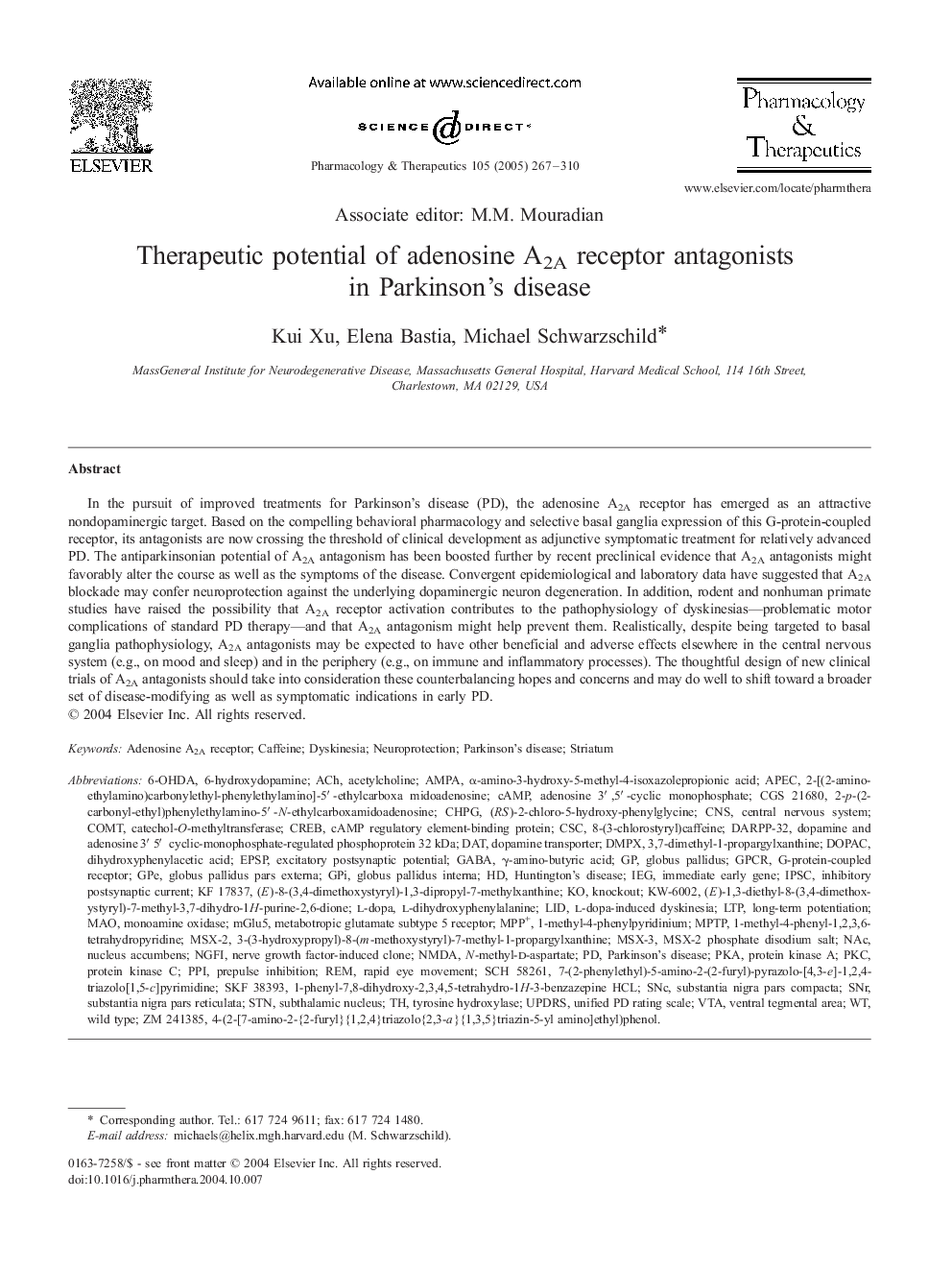| کد مقاله | کد نشریه | سال انتشار | مقاله انگلیسی | نسخه تمام متن |
|---|---|---|---|---|
| 9016113 | 1127655 | 2005 | 44 صفحه PDF | دانلود رایگان |
عنوان انگلیسی مقاله ISI
Therapeutic potential of adenosine A2A receptor antagonists in Parkinson's disease
دانلود مقاله + سفارش ترجمه
دانلود مقاله ISI انگلیسی
رایگان برای ایرانیان
کلمات کلیدی
IPSCDARPP-32Substantia nigra pars reticulataMPTPNMDAN-methyl-d-aspartateGPCRCOMTVTADOPACREMSTN1-methyl-4-phenylpyridiniumMAOPKCCSCGPiUPDRSIEGCHPGSKF 38393Mglu5globus pallidus pars externaDMPXAPECCGS 21680KW-6002ZM 241385SCH 58261Msx-2NACPPICREB6-HydroxydopamineLIDCatechol-O-methyltransferasepKaAMPA6-OHDASNCSNRDATGPE1-methyl-4-phenyl-1,2,3,6-tetrahydropyridine - 1-methyl-4-phenyl-1،2،3،6-tetrahydropyridine3,7-dimethyl-1-propargylxanthine - 3،7-دی متیل-1-پروپارگیلکسانتین8-(3-chlorostyryl)caffeine - 8- (کلسترویلی) کافئینcAMP - cAMPEPSP - epspiG-protein-coupled receptor - G-پروتئین گیرندهl-DOPA - L-DOPAl-dihydroxyphenylalanine - L-دی هیدروکسی فنیل آلانینMPP+ - MPP +γ-amino-butyric acid - γ-آمینو اسید بوتیریکadenosine 3′,5′-cyclic monophosphate - آدنوزین 3 '، 5'-سیکلیک منوفسفرهACh - آهStriatum - استریاتومAcetylcholine - استیل کولینα-amino-3-hydroxy-5-methyl-4-isoxazolepropionic acid - اسید α-آمینو 3-هیدروکسی-5-متیل-4-ایزوکسول پپونیکDopamine transporter - انتقال دهنده دوپامینglobus pallidus interna - بغض در گلو بین المللی سنکHuntington's disease - بیماری هانتینگتونParkinson's disease - بیماری پارکینسونlong-term potentiation - تقویت درازمدتLTP - تقویت طولانی مدت یا LTP substantia nigra pars compacta - توده سیاه پارس متراکمtyrosine hydroxylase - تیروزین هیدروکسیلازinhibitory postsynaptic current - جریان پستانیپتیک مهارکنندهrapid eye movement - حرکت سریع چشمCNS - دستگاه عصبی مرکزیdihydroxyphenylacetic acid - دی هیدروکسی فنیل اسیدهای اسیدdyskinesia - دیسکینزیL-DOPA-induced dyskinesia - دیسکینزی ناشی از L-DOPAcentral nervous system - سیستم عصبی مرکزیNeuroprotection - محافظت نورونی یا محافظت از عصبPrepulse inhibition - مهار پیش قاعدگیmonoamine oxidase - مونوآمین اکسیدازها ventral tegmental area - ناحیه تگمنتوم شکمیknockout - ناکاوتwild type - نوع وحشیNucleus accumbens - هسته accumbensSubthalamic nucleus - هسته ی زیرهالامیکexcitatory postsynaptic potential - پتانسیل پست سیناپتی هیجان انگیزprotein kinase A - پروتئین کیناز AProtein kinase C - پروتئین کیناز سیimmediate early gene - ژن فوری اولیهCaffeine - کافئینGABA - گاباGlobus pallidus - گوی رنگ پریده، گلوبوس پالیدوسAdenosine A2A receptor - گیرنده آدنوزین A2A
موضوعات مرتبط
علوم پزشکی و سلامت
داروسازی، سم شناسی و علوم دارویی
داروشناسی
پیش نمایش صفحه اول مقاله

چکیده انگلیسی
In the pursuit of improved treatments for Parkinson's disease (PD), the adenosine A2A receptor has emerged as an attractive nondopaminergic target. Based on the compelling behavioral pharmacology and selective basal ganglia expression of this G-protein-coupled receptor, its antagonists are now crossing the threshold of clinical development as adjunctive symptomatic treatment for relatively advanced PD. The antiparkinsonian potential of A2A antagonism has been boosted further by recent preclinical evidence that A2A antagonists might favorably alter the course as well as the symptoms of the disease. Convergent epidemiological and laboratory data have suggested that A2A blockade may confer neuroprotection against the underlying dopaminergic neuron degeneration. In addition, rodent and nonhuman primate studies have raised the possibility that A2A receptor activation contributes to the pathophysiology of dyskinesias-problematic motor complications of standard PD therapy-and that A2A antagonism might help prevent them. Realistically, despite being targeted to basal ganglia pathophysiology, A2A antagonists may be expected to have other beneficial and adverse effects elsewhere in the central nervous system (e.g., on mood and sleep) and in the periphery (e.g., on immune and inflammatory processes). The thoughtful design of new clinical trials of A2A antagonists should take into consideration these counterbalancing hopes and concerns and may do well to shift toward a broader set of disease-modifying as well as symptomatic indications in early PD.
ناشر
Database: Elsevier - ScienceDirect (ساینس دایرکت)
Journal: Pharmacology & Therapeutics - Volume 105, Issue 3, March 2005, Pages 267-310
Journal: Pharmacology & Therapeutics - Volume 105, Issue 3, March 2005, Pages 267-310
نویسندگان
Kui Xu, Elena Bastia, Michael Schwarzschild,